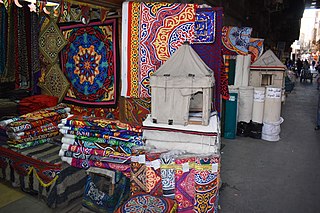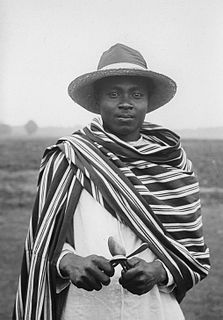 W
WAdire textile is the indigo-dyed cloth made in southwestern Nigeria by Yoruba women, using a variety of resist-dyeing techniques.
 W
WAfrican textiles are textiles from various locations across the African continent. Across Africa, there are many distinctive styles, techniques, dyeing methods, and decorative and functional purposes. These textiles hold cultural significance and also have significance as historical documents of African design.
 W
WAfrican wax prints, also known as Ankara and Dutch wax prints, are omnipresent and common materials for clothing in Africa, especially West Africa. They are industrially produced colorful cotton cloths with batik-inspired printing. One feature of these materials is the lack of difference in the color intensity of the front and back sides. The wax fabric can be sorted into categories of quality due to the processes of manufacturing.
 W
WAkwete cloth is a unique hand woven textile produced in Igboland for which the town of Akwete in Abia state, Nigeria is famous. The traditional Igbo weaving as demonstrated in Akwete processes sisal, hemp, raffia, cotton or other fibres into finished products. While the coarse raffia materials are used by masquerades and in the past as head gear for warriors among other uses, the hemp material was used to weave towels, ropes and handbags. The more comfortable and colorful spun cotton is used to weave cloth for everyday wearing.
 W
WAso oke fabric, is a hand-woven cloth created by the Yoruba people of west Africa. Aso oke means "top cloth" in the English language, denoting cloth of high status. Usually woven by men and women, the fabric is used to make men's gowns, called agbada and hats, called fila, as well as women's wrappers, called iro and head tie, called gele.
 W
WBògòlanfini or bogolan is a handmade Malian cotton fabric traditionally dyed with fermented mud. It has an important place in traditional Malian culture and has, more recently, become a symbol of Malian cultural identity. The cloth is exported worldwide for use in fashion, fine art and decoration.
 W
WKhayamiya is a type of decorative appliqué textile historically used to decorate tents across the Middle East. They are now primarily made in Cairo, Egypt, along what is known as the Street of the Tentmakers centered in the Qasaba of Radwan Bey, a historic covered market built in the 17th century. The street is located immediately south of Bab Zuweila, and is located along the historic economic axis of Cairo.
 W
WKorhogo cloth is an African textile made by the Senufo people of Korhogo, Ivory Coast. Often described as being in the shadows of bogolafini and kente, korhogo comes in neutral and earthy tones like browns, blacks and creams. Korhogo is made by hand painting designs on hand woven and hand spun cotton fabric. The paintings are done using a specially fermented mud-based and natural vegetal pigment that darkens over time, and designs are usually drawn on using a stencil. They are decorated with symbols of humans, natural elements like the sun, moon and stars and animals, all of which are rooted in Senufo culture and mythology. The Senufo use the cloth as a shield against vengeful spirits by wearing or hanging them in homes/shrines. Korhogo is commissioned for hunters and rite of passage events like funerals/special ceremonies.
 W
WA lamba is the traditional garment worn by men and women that live in Madagascar. The textile, highly emblematic of Malagasy culture, consists of a rectangular length of cloth wrapped around the body.